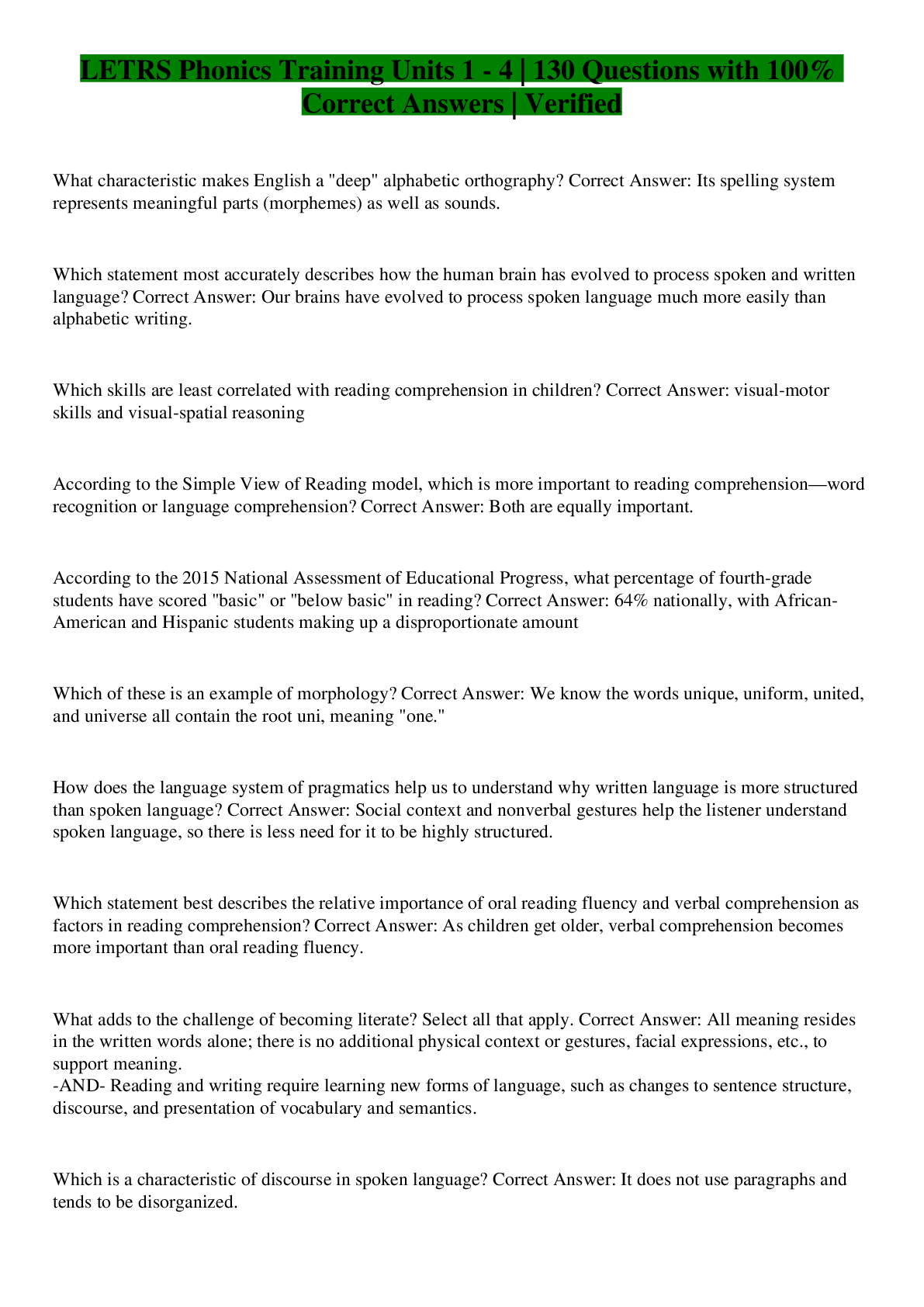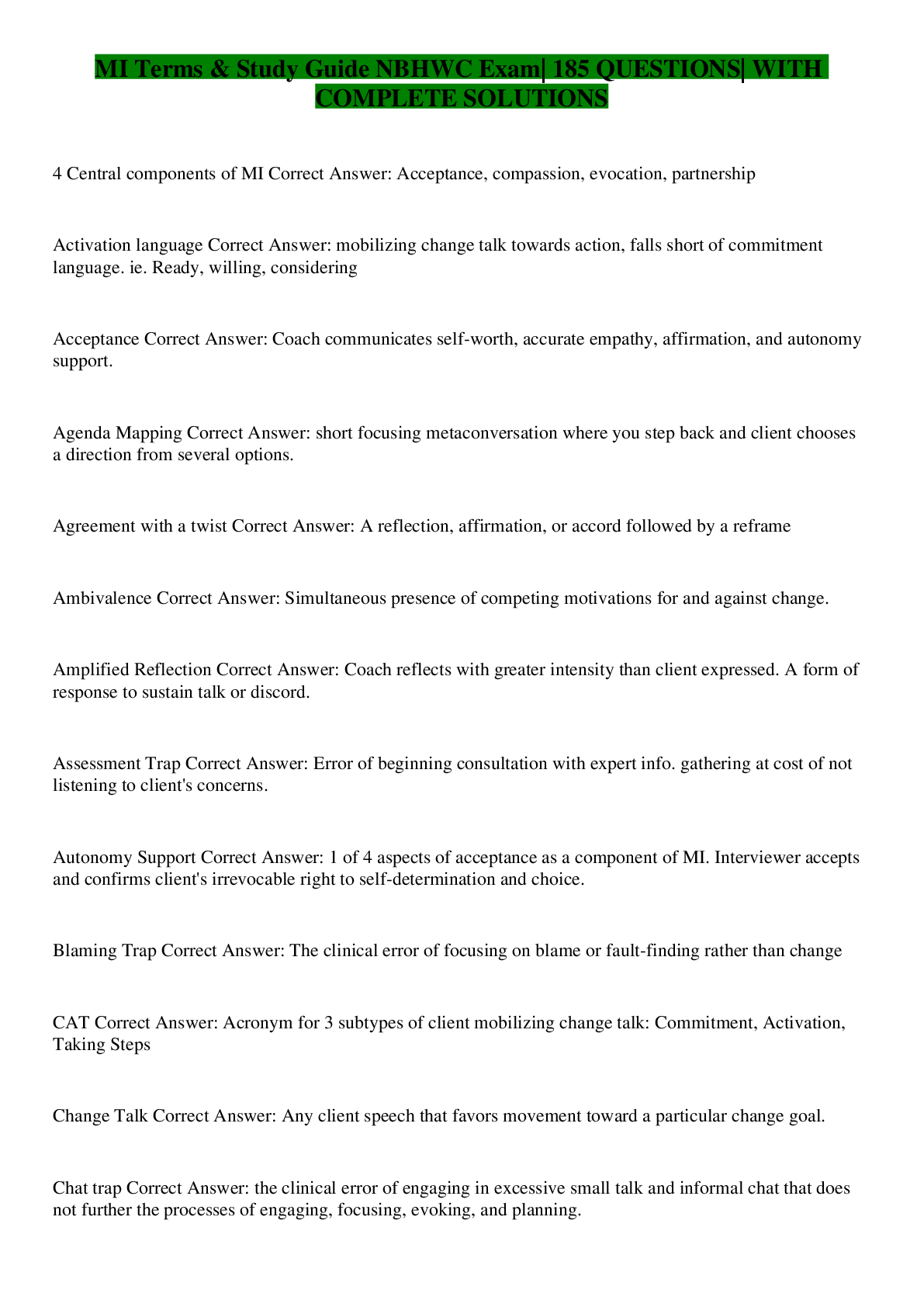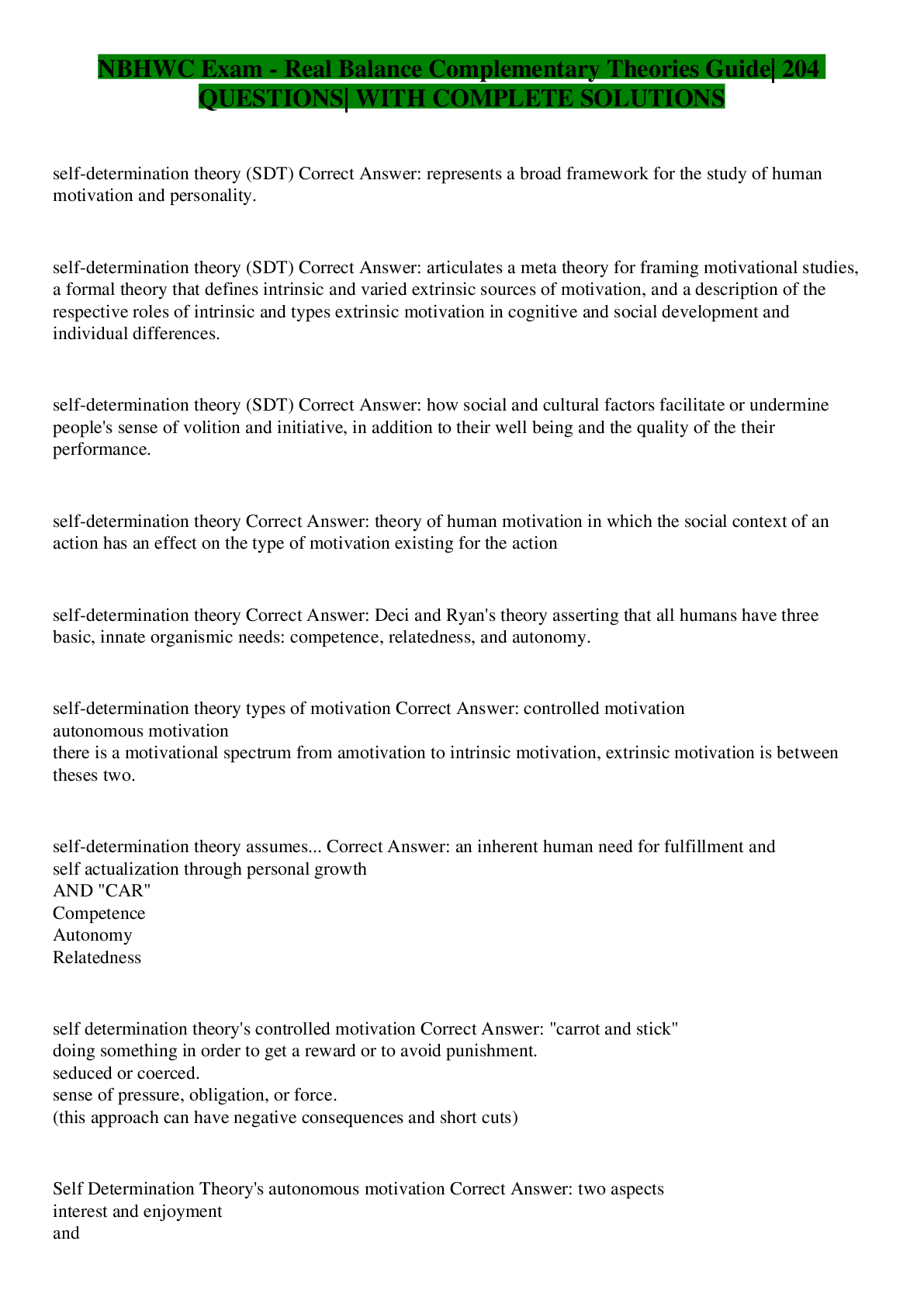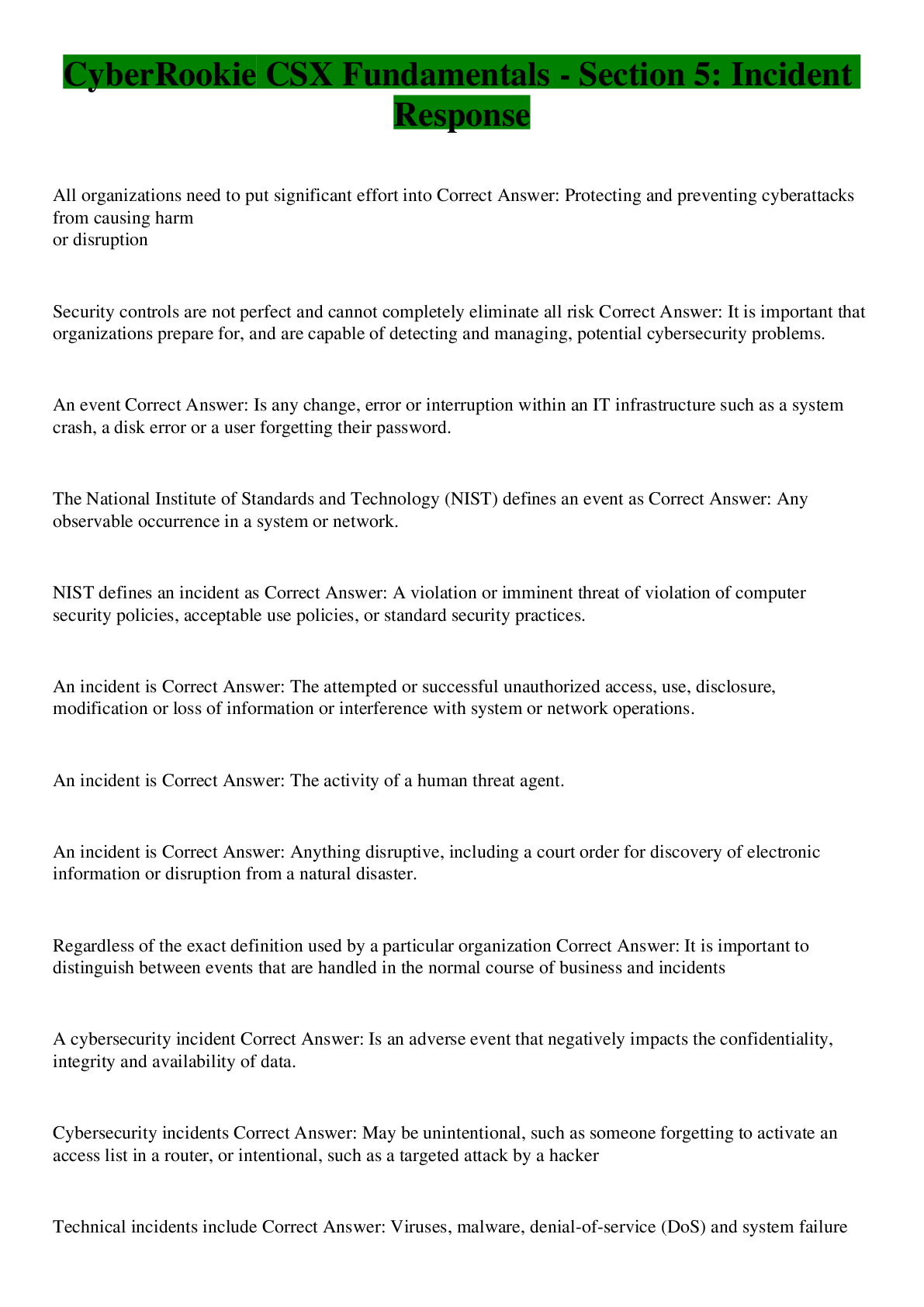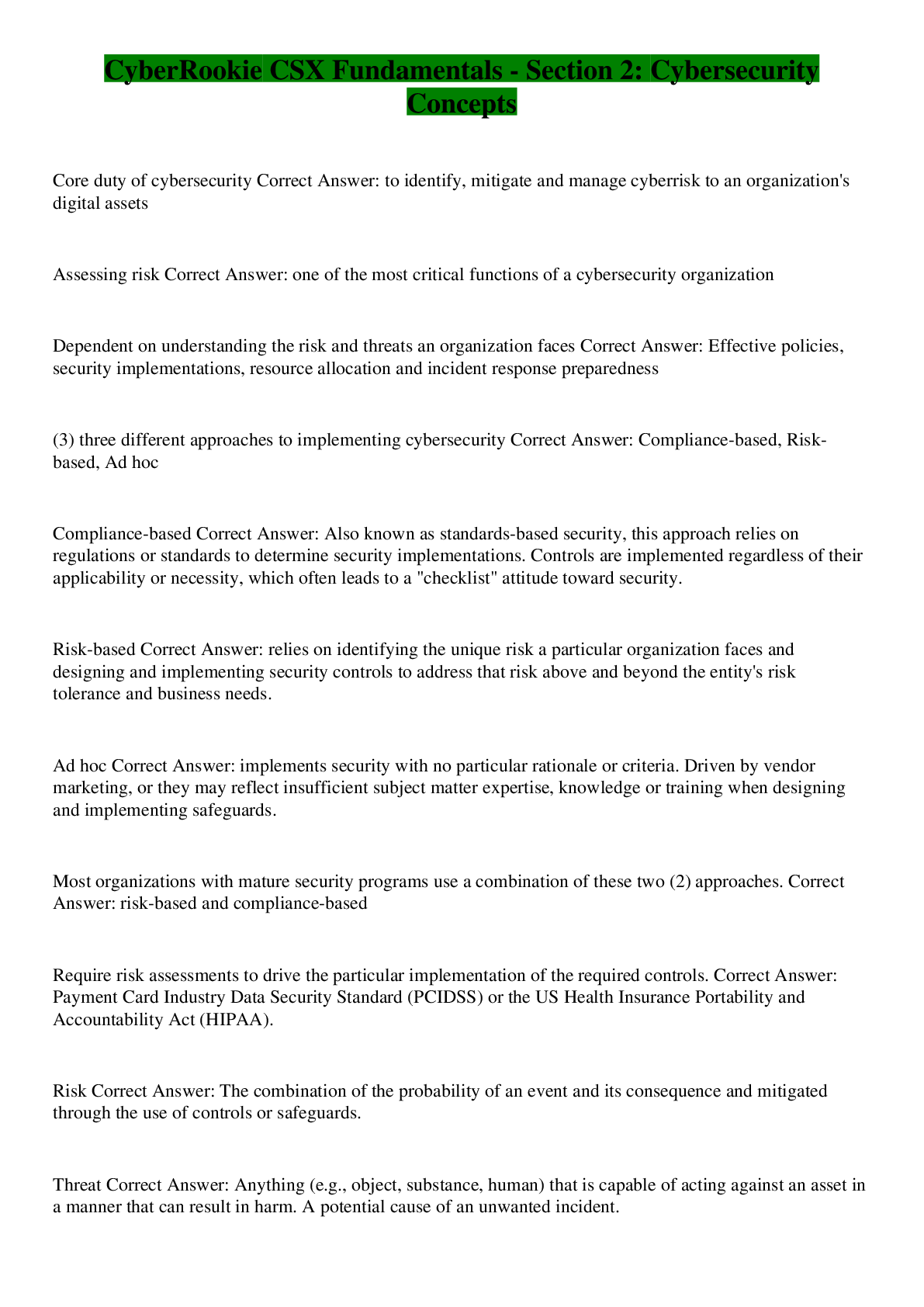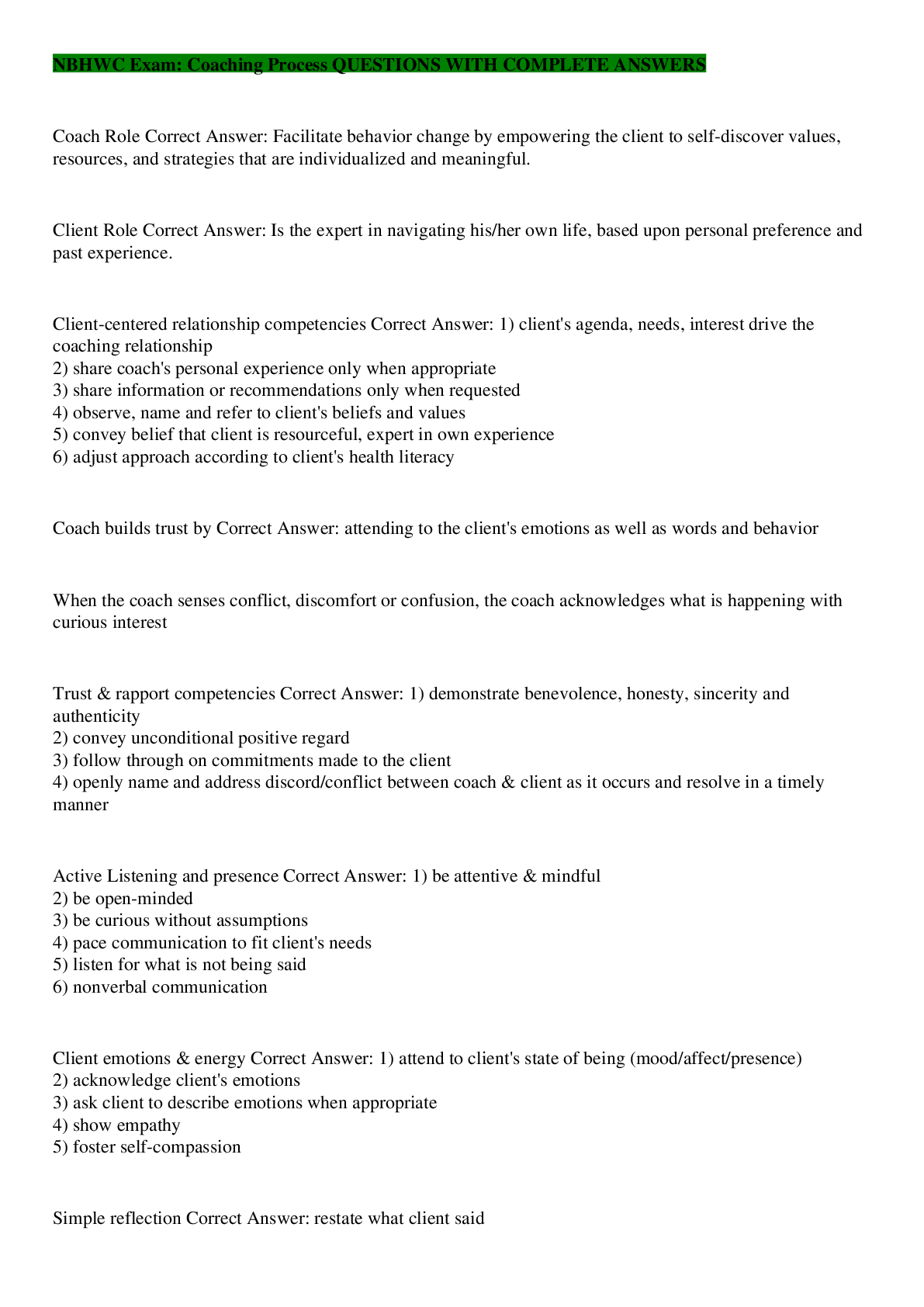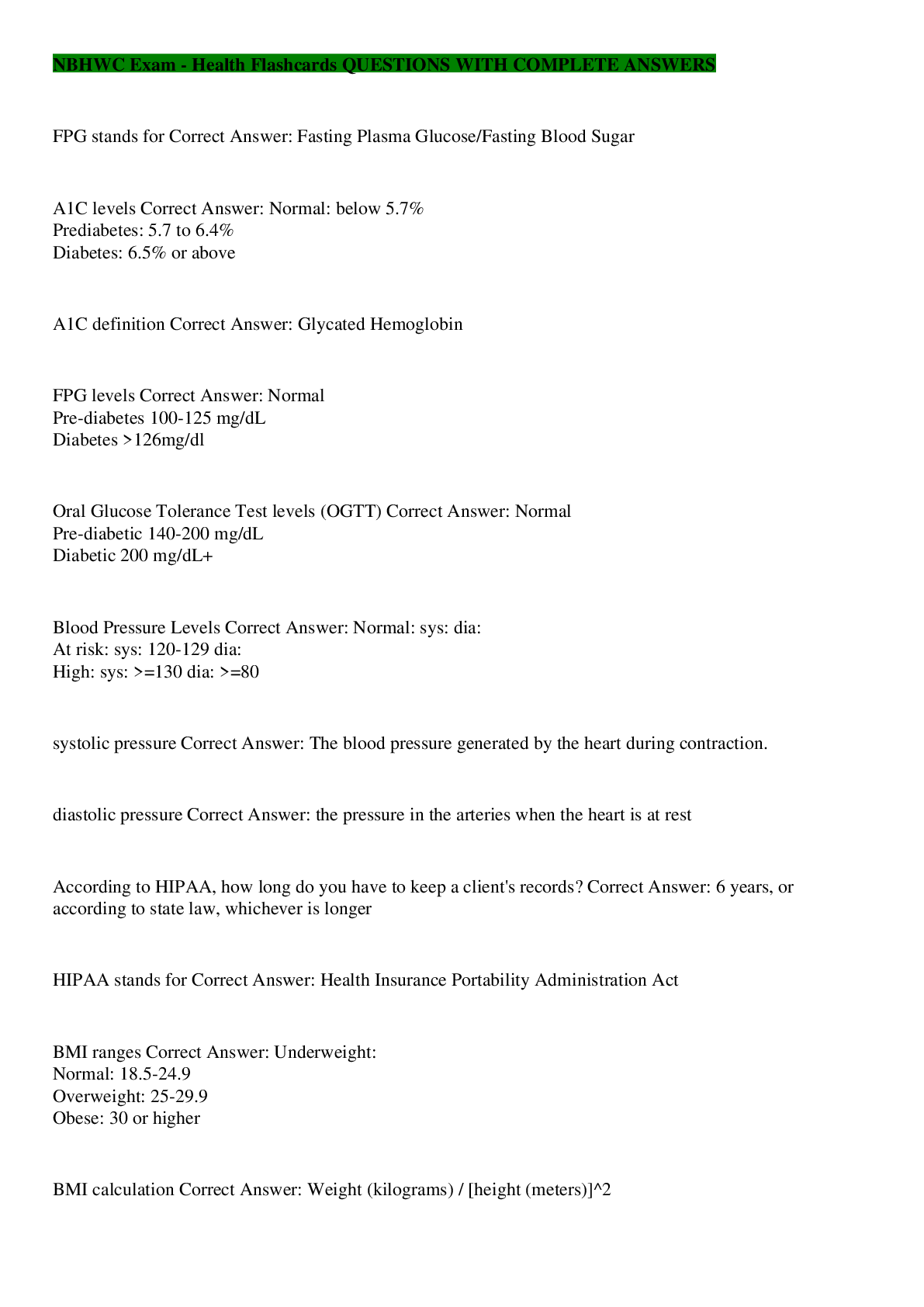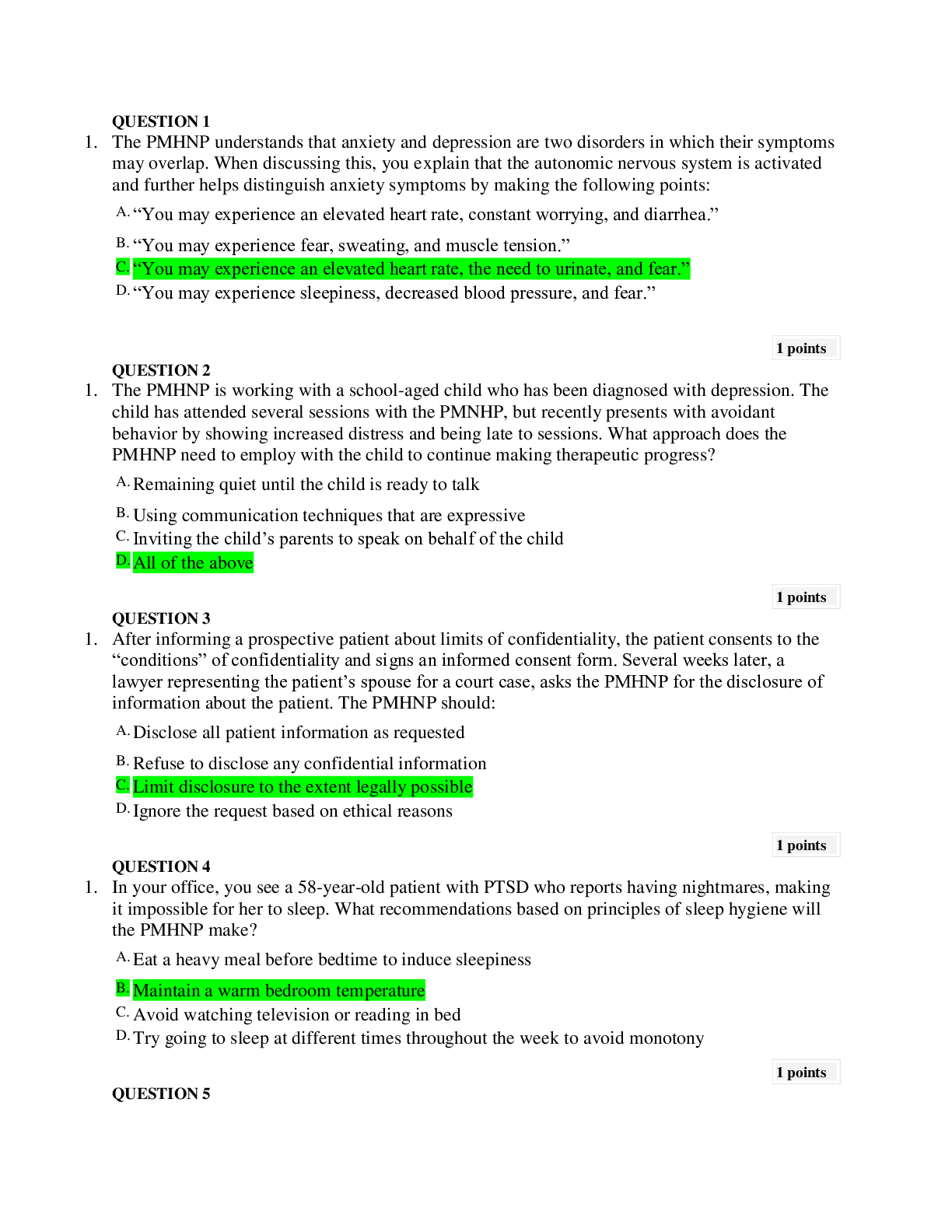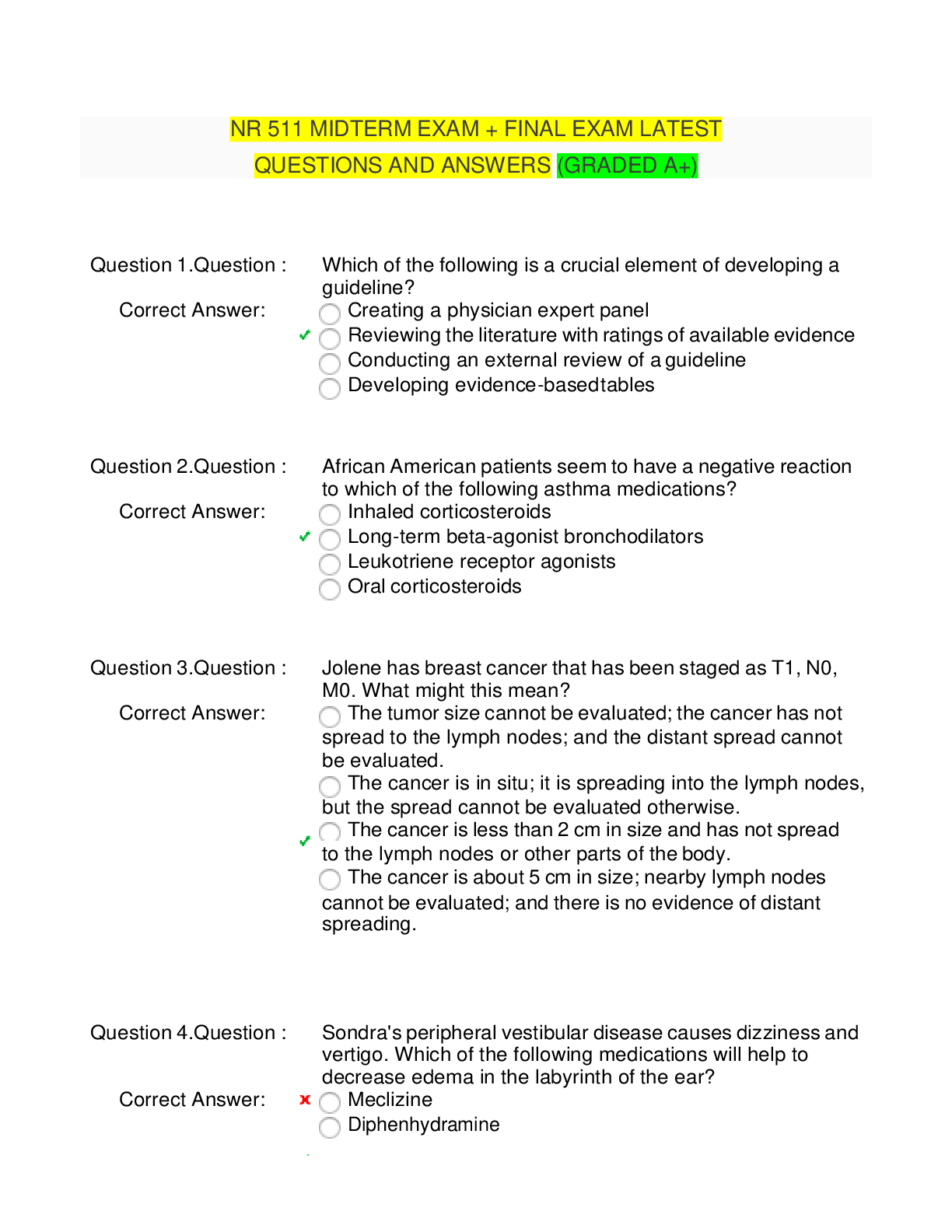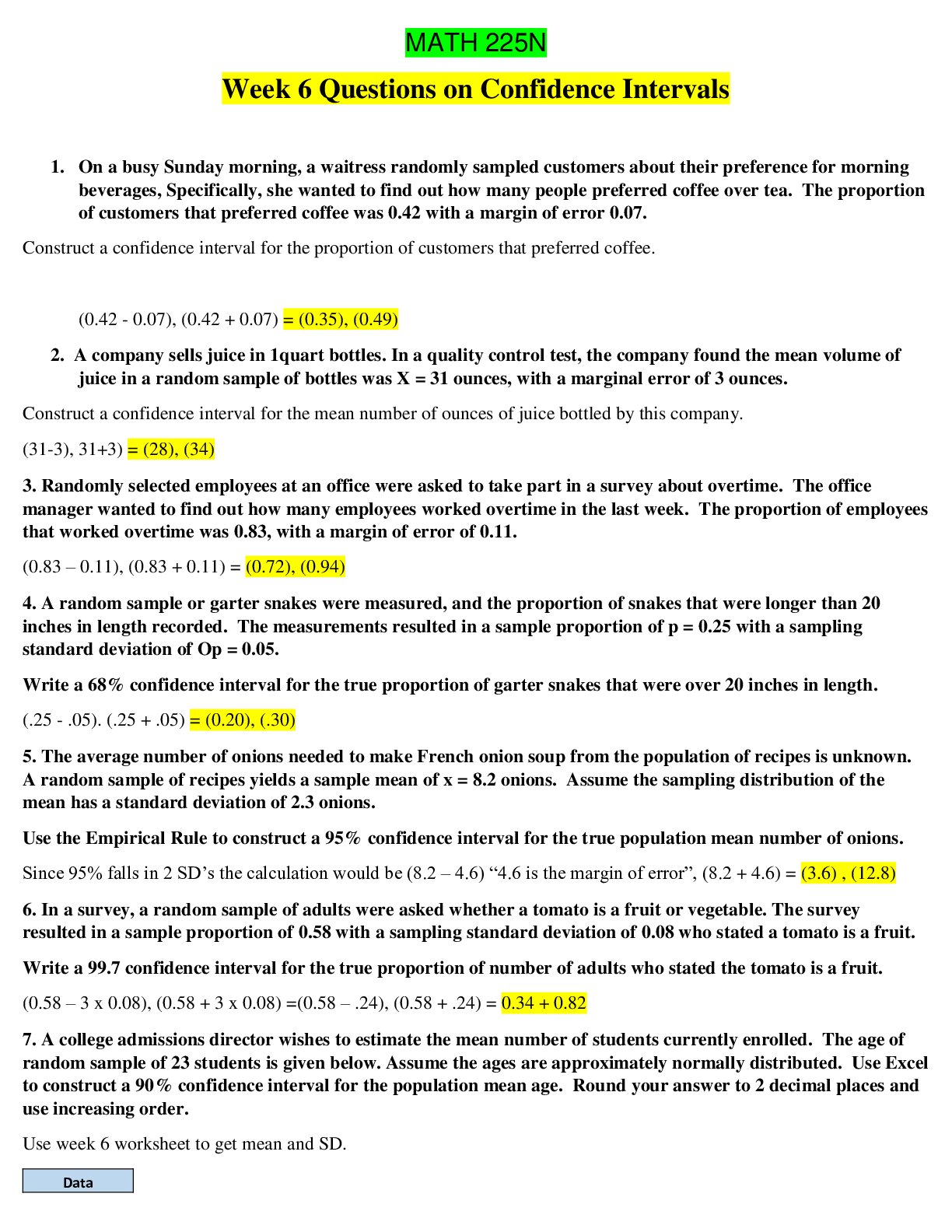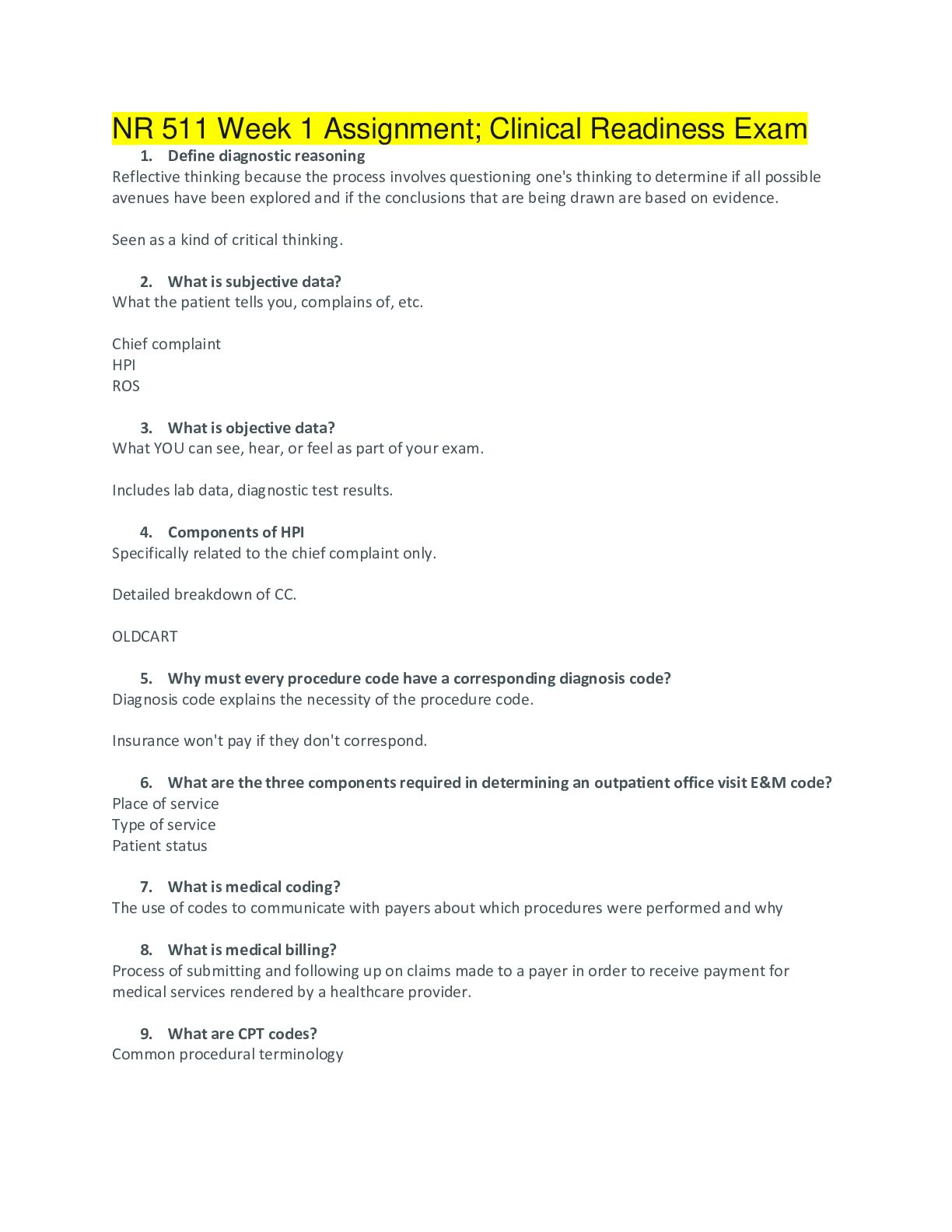Health Care > EXAM > MCH Exam 3 Study Guide QUESTIONS AND ANSWERS 100% CORRECT (All)
MCH Exam 3 Study Guide QUESTIONS AND ANSWERS 100% CORRECT
Document Content and Description Below
MCH Exam 3 Study Guide Hospitalization causes many issues - Stress is the Big one. This can be positive and negative, please explain.Answer- Positive - Child begins to expand their world when p... arents are absent. Healthcare providers can see the child adapt. If parents are gone too long........abandonment can set in. **Stress helps them learn how to cope. -Negative - Long term stress (not good), however display itself in physical manifestation. Ways to interact friendly interchange with parents/address child:Answer- *No medical jargon -Get to their eye level, engage child and address child -Talk slowly & clearly (concrete words) assess child's cognitive ability -Utilize play, transitional objects, drawings, colors, pictures -Use a child life specialist to assist with communication & interactions -Allow child to make noise and be upset, give child something to do. [Make nice with parents] What is the child most afraid of - 3 things?Answer- 3 big stressors: -losing control or independence -their punishment/pain -change in body images. **[separation from parent and family, fear of unfamiliar, fear of pain and loss of control] How can we minimize the stress of hospitalization?Answer- **Alleviate stress and fears: ask parents stay participate, explain procedure, and provide distractions **Ways to min. stress - rooming in w/ patient [parent should be primary source for coping & comfort], bring an object from home, draw pic to hang in room, offer choices of watching movie or picking a game, therapeutic play, child life specialist, guided imagery, role modeling (decrease fear and anxiety and coping skills), move to procedure room [not in their own room] Separation anxietyAnswer- -Refers to severe distress that occurs when a child is separated from his or her primary caretaker-Begins 6 months of age and peaks in intensity at 14-18 months and then gradually declines;start to accept fact that parents will come back. How do we communicate with children?Answer- Children in general - Get to their level physically. Simple words. Eye contact. Play to demonstrate. Approachable. Communication: Hearing deficitAnswer- sign language, pictures, computerized electronics, eye contact, touch, turn light on. Gain their attention before speaking, face child when speaking, speak slowly and loudly. Communication:Visual deficitAnswer- announce yourself, let them know that you are there. Keep routine in the room the same. Make sure they have their glasses on. Bright lights. Communication: Cognitive issuesAnswer- Be gentle and kind, very short directives. Praise. Hold boundaries. Adapting to deficitsAnswer- **Child will learn to adapt to deficits quickly, better to recognize problem early on before they adapt, then harder to find the problems. May adapt to disabilities so that you may not notice them Basic fears of children are:Answer- separation, abandonment and fear of pain/unknown. [Infants from 6 mos. through toddler hood - fear of separation.] Separation comfort careAnswer- -with favorite items or activity, distraction, parents room in or go with child to procedures. -Child will protest separation due to anxiety, [prep with tours and explanation, use transitional objects] reinforce when they will see parent again. -Despair follows due to grief of separation, detachment due to ongoing anger/coping skills. Alleviate stress and fears:Answer- -explain procedure -distraction -ask parent to stay and participate in care -explain what's going on HOW they play in each of these stages? Note: primary school they tend to play in single sex groups.....and in high school they group by interest groups.Answer- *5 types of play • Solitary (0-2 Years) - infant/ toddlers. Adolescent. Child should be socialized. Can be at any stage, but do not want this type of play only • Parallel (2.5-3 Years) - toddlers. Two toddlers doing the same task, hasn't learned to play with each other. Egocentric. (two children playing together but oblivious to the fact, don't understand the concept of someone outside of themselves) • Associative (3-4 Years) - preschool, early child. Get together to something accomplished, but no rules. • Organized/cooperative (4-6 Years) - school aged/adolescents. Organized sports, rules. Concept of rules upholding. Need moderators. Sports w/Rules • Onlooker/Spectator (2-2.5 Years) - toddlers, young preschool. RED flag if it continues with this type of play; autism, cognitive development problems (can see in toddler or preschooler, but should want to participate) What is the benefit of play?Answer- - learn to socialize -learning society rules -communication; express thoughts -learning fine & gross motor skills -creativity & conceptualize -master skills -get stronger (muscles) -Enables child to explore, express, solve problems -Cognitive and Physical development, helps form independence over time. -provides psychosocial needs of child Nutrition is:Answer- the single most important factor in the growth and development of children. Are food fads that different children encounter harmful?Answer- -No, and are usually self- limiting. -Adolescents have many different needs for greater caloric intake and more concentrated iron, folic acid, and protein. Nutritional needs for baby's/infantsAnswer- -breast milk or formula for 1 full year. -Solids; at around 6 mo. when Surge of growth is the greatest. Toddlers: Food fads a problem?Answer- -No, food fads are not really a problem. -picky eaters, physiological anorexia "grazers". Introduce healthy snack foods. -They may incur physiological anorexia and physiological anemia due to the milk ingestion. Nutritional assessmentsAnswer- [In toddlers] **Too much calcium= Anemia because "calcium impedes iron absorption" -Adolescents (puberty)- surge of growth. Muscle mass. -Anorexia - Not eating; Control issues, body dysmorphia. -Bulimia - Binge and purge; Body dysmorphia. Risks with inadequate nutrition:Answer- • Cardiac and organic failure, electrolytic imbalance, cardiac dysrhythmia, tooth enamel erosion, esophageal damage. Kids are obsessive picky eaters. • Older kids become obsessive and restrictive. • Over-eaters think about meals before all else. • In little kids they can become constipated, unhealthy. • Anemia can be an issue. Food fads are not uncommon and if the child has a daily food intake that is overall balanced, the parent should be comforted and instructed to continue to track the intake. Nutritional needsAnswer- -Infant- breast feed up to 1 year, no milk prior -Solid foods - around 6 mo., slowly new food every 3-4 days -Toddlers - picky eaters, physiological anorexia, grazers; no food fads are detrimental unless purposely not eating. -Growth problems if not receiving proper amount of proteins: Ask what they like (if don't like milk find another option for calcium) **Too much milk can cause anemia [Ca impedes iron absorption] Rate of growthAnswer- Greatest growth in infants, and then again in adolescents which puts them at risk for anemia due to menstruation and muscle mass increase. RestraintsAnswer- - are used for procedures to keep children safe. *MUST BE ORDERED!* *2 common types of restraints- mummy and elbow restraints. • Elbow prevents elbow flex - can't reach things to pull/touch. • Mummy is swaddling and whole body stabilization. Used for procedures and medication administration. **Restraints 411:Answer- -Must be removed every 2 hours. -Parent teaching and return demonstrations must be validated. -Chemical restraints are sedation. Can be used to reduce anxiety. **Airway MUST BE MANAGED at all times. Child must be under direct surveillance at all times. Reasons for RestraintsAnswer- -Safety; keep patient safe, procedures **Restraints: used for procedures to keep safe and postoperatively (prevent pulling of IV or sutures) Consents - for invasive procedures [*Need signature consent for invasive procedures; from parent, guardian or emancipated; pregnant, military, court order]Answer- -If a child is of age, they don't need their parent's signature. -If emancipated they can sign as well. If not the parent must sign. -In emergencies physician can approve if parents are not available. -Religious beliefs can be overturned by courts in some cases. *Consents are Voluntary, understanding of procedure [cognitive/language barriers; interpreter if needed], attempt to contacts [document] telephone attempt; life or limb. Discipline is for:Answer- -Safety and education with positive reinforcement; to make good choices, aggressiveness with toddlers because they don't remember: -Withholding, time out, rationalizing, distractions Harmful disciplinesAnswer- -Corporal punishment [okay to hit, slap or harm] -Isolation (in some cases) -Demoralizing; screaming/verbal abuse -Neglect - passive aggression. Types: Authoritarian- dictator & Authoritative/democratic (is most effective) *Parent can go in and out of different style modes sometimes Beneficial disciplineAnswer- Time out [without isolation], redirection, distraction, positive reinforcement, modeling preferred /desired behavior, removal of privileges, natural consequences of actions. Pain is a frequent assessment done on all patients - what about pain assessments in children?Answer- *Manage as you would an adult. -Pain scales- Faces and FLACC are preferred. *For children 10-12 years old can use the numerical pain scale. -Believe the child's report. [Show More]
Last updated: 1 year ago
Preview 1 out of 24 pages
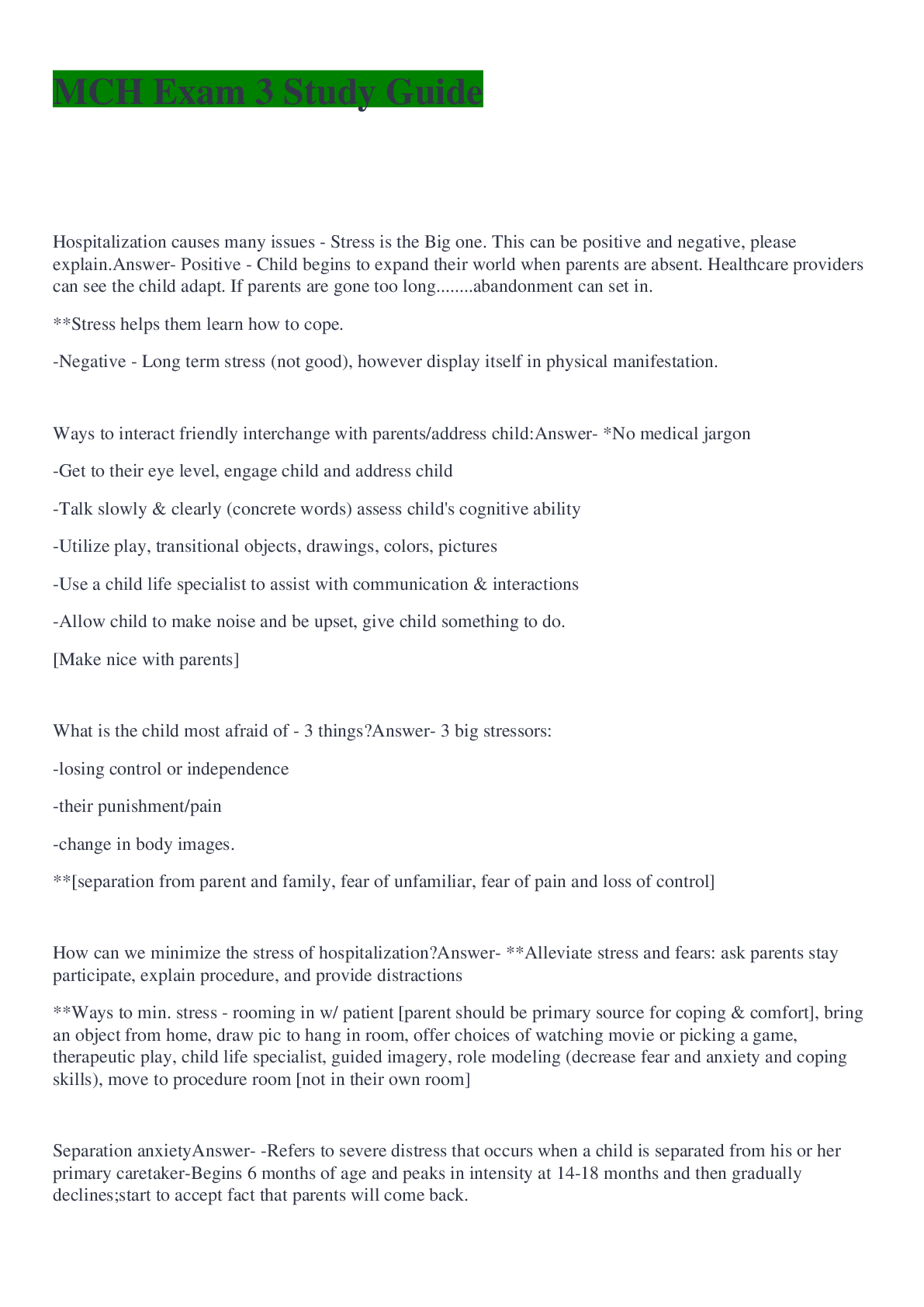
Buy this document to get the full access instantly
Instant Download Access after purchase
Add to cartInstant download
We Accept:

Reviews( 0 )
$13.00
Document information
Connected school, study & course
About the document
Uploaded On
Sep 15, 2022
Number of pages
24
Written in
Additional information
This document has been written for:
Uploaded
Sep 15, 2022
Downloads
0
Views
32


